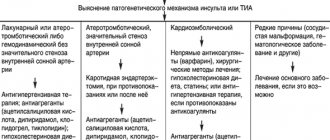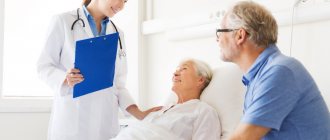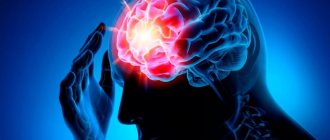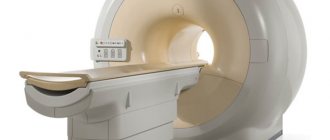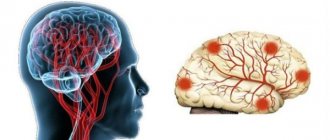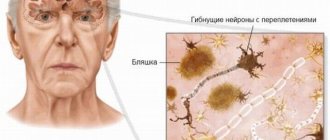From this article you will learn:
- What is a stroke and how does the disease manifest?
- What are the warning signs of a stroke and can it be prevented?
- What drugs and medications should people prone to strokes take?
- How to prevent another stroke
How to prevent a stroke? Is it possible to avoid this insidious disease, which kills more than 6.5 million people every year? The answer is yes! And doing this is much easier than rehabilitating a person who has already had a stroke.
What is a stroke
A stroke is a sudden dysfunction of blood circulation in the brain. There are two main types of stroke: ischemic and hemorrhagic. In ischemic stroke, cerebral circulation is disrupted as a result of spasm and/or blockage of blood vessels. In a hemorrhagic stroke, the rupture of blood vessels leads to an outpouring of blood into the brain. Despite the fact that there are three times more cases of ischemic stroke, the mortality rate as a result of this type of stroke is significantly less than as a result of hemorrhagic stroke. Blood performs a transport function, delivering nutrients to the brain. Starting from the main artery (aorta), it flows through the vessels, entering the cranium through two pairs of carotid arteries - in front and behind, after which the circulatory system branches into many small vessels. Thus, a disruption in the functioning of any of them leads to a lack of nutrients in the nervous tissue and, as a consequence, to ischemia . Stroke is considered to be a seasonal disease, the peak of which, as a rule, occurs in the spring . In our country, there are an average of 400,000 cases per year. The majority of stroke survivors experience “side effects”—headaches, impaired speech function, and paralysis. Brain hemorrhage often occurs as a result of prolonged exercise or stressful situations.
Most often, this disease occurs in older people, occurring against the background of vascular arteriosclerosis and hypertension. There are often cases when patients are hospitalized directly from their summer cottages, where they carry heavy objects and spend a lot of time bending over the beds. Recommended articles to read:
- Social services for older people
- Diseases of old age
- Valuable tips on how to choose a boarding house
Who's at risk
Objectively, there are categories of people who have a high likelihood of developing a stroke. These include:
- people with diabetes, high blood pressure and cholesterol;
- people with a hereditary predisposition to this disease;
- people with blood pressure higher than normal (120 over 80);
- women over 55 years of age;
- all people over 65.
Read material on the topic: Features of the elderly
Blood pressure control
One of the main risk factors for stroke is high blood pressure. With hypertension, the lumens of the arteries narrow, which creates favorable conditions for their blockage with blood clots.
To prevent stroke, it is necessary to regularly monitor blood pressure levels and normalize them with the help of antihypertensive drugs.
If you have hypertension, you must have a blood pressure monitor and measure your blood pressure every morning and evening. This is done like this:
- The tonometer cuff is put on so that it is at the level of the heart, and the phonendoscope membrane is on the inside of the elbow.
- There should be no tight clothing, legs should be close together.
- Inflate the air, making sure that the cuff does not rest against your side.
- Release the air gradually, noticing the pressure gauge needle on the first and last strokes. This will be the systolic (upper) and diastolic (lower) pressure.
If blood pressure exceeds the norm (120/80 mm HH), then you need to consult a doctor to prescribe antihypertensive drugs and take them constantly.
The first warning signs of a stroke
In the vast majority of cases, approximately one day before a stroke, periodic disruptions in the movement of blood through the vessels of the brain begin to occur, which manifests itself in the following symptoms :
- headache;
- general discomfort;
- temporary disorder of consciousness.
Typically, an ischemic cerebral stroke develops within a few hours, but in some cases this process takes several days. The first symptoms appear at night or in the morning, appearing and disappearing. The face acquires a pale and sometimes blue tint, the sensitivity of the skin decreases, and disturbances in olfactory, speech and visual functions are observed. The patient may not recognize people and objects. Hemiparesis is observed on the side of the body opposite the brain hemisphere affected by the stroke. A hemorrhagic stroke usually has no warning in advance. An attack occurs during the greatest physical and mental stress, that is, as a rule, during the day. Symptoms of a hemorrhagic stroke sudden changes in body temperature, sweating, a red complexion, a jump in blood pressure and difficulty breathing. The patient feels a severe headache and faints. Using the so-called “sail” symptom , in which one of the patient’s cheeks inflates when exhaling, a hemorrhagic stroke can be diagnosed. It can also be identified by weak muscle tone and everted foot.
Physical activity
One of the main factors leading to sclerotic vascular lesions is a lack of physical activity. Physical inactivity contributes to:
- the development of obesity, which is one of the indirect causes of stroke;
- increased blood pressure and weakened heart muscle function;
- deterioration of the lipid profile, which contributes to the deposition of cholesterol plaques;
- increased blood viscosity, which causes blood clots;
- deterioration of the protective function of the inner surface of blood vessels, due to which its cells are less resistant to cholesterol deposits.
To avoid these negative phenomena, you need to move more. If you have a sedentary job, walk at least part of the way to it, do not use elevators, choose a type of physical education that you like and do it at least 3 times a week. Spend your weekends moving in the fresh air. Following these recommendations is one of the most important measures to prevent stroke.
Is it possible to prevent a stroke?
Unfortunately, it is not uncommon for patients to become disabled after a stroke. To prevent the sad consequences of acute cerebral circulatory failure, people prone to this disease, as well as their loved ones, should be on alert and not ignore symptoms such as sudden weakness, partial dysfunction of the speech apparatus, numbness of the limbs. Even if the described processes are short-term and pass quickly, they are not less dangerous. The appearance of such precursors of a stroke in your life should prompt you to change your lifestyle. First of all, changes should concern the food system .
It is necessary to reduce the amount of fats, smoked foods, fried foods in your diet, and also use salt as little as possible. Vegetables, fruits, berries - these are the products that should appear on your menu as often as possible. Read material on the topic: Nutrition for the elderly
Numerous studies have concluded that
the likelihood of developing ischemia is reduced by 5% for each serving of plant foods.
First of all, this should include foods enriched with vitamin C, such as greens, citrus fruits, and various types of cabbage. One serving might look like this:
- one apple, banana or orange;
- 150-180g. berries (strawberries, raspberries, currants, gooseberries, blueberries, etc.);
- a glass of fruit juice;
- a tablespoon of dried fruits;
- two tablespoons of vegetables;
- salad dish.
By studying the food preferences of stroke patients and their peers who do not suffer from this disease, Finnish scientists came to the conclusion that eating one apple a day can significantly reduce the likelihood of developing cerebral circulatory disorders.
According to scientists, such a positive effect of apples is caused by the phenolic acids contained in the fruits. This substance belongs to the category of antioxidants - chemical compounds that interfere with the formation of radicals that have a destructive effect on blood vessels. Thus, phenolic acids have a positive effect on blood vessels, reducing the likelihood of their blockage, blood clots and destruction.
Medicines and drugs to prevent stroke
Medicines used to prevent stroke can be divided into the following groups:
- antihypertensive drugs (enalapril, lisinopril, etc.). People with hypertension have a greater risk of developing stroke. Drugs in this group, their dosage and methods of administration are prescribed by a doctor;
- antiplatelet agents (thromboass, cardiomagnyl, aspirin). These drugs help prevent blockage of blood vessels and the formation of blood clots. They are also prescribed by a doctor, but, as a rule, they are taken according to the scheme one month on - a month off;
- diuretics (Lasix, furosemide, etc.) are medications that remove excess sodium from the body and relieve swelling.
Under no circumstances should you take medications on your own. The choice of drug, the schedule for its administration and dosage should be prescribed exclusively by a qualified specialist, since a lot depends on the individual characteristics of the body and the current clinical picture. Otherwise, you may not only not help the body avoid a stroke, but also cause significant harm to it.
Monitoring blood counts
Women who are at risk for stroke (having hypertension, diabetes, age after menopause), especially if there is a hereditary predisposition and bad habits, need to take blood tests at least once a year:
- for sugar;
- for cholesterol (lipid profile);
- on blood clotting.
These are the most important indicators characterizing the condition of the arteries, which directly affects the likelihood of a stroke.
Controlling the levels of sugar, cholesterol, blood clotting and maintaining them within normal limits is one of the most important measures for the prevention of atherosclerosis and stroke.
If the analysis shows an excess of blood sugar, it is necessary to take urgent measures to normalize it through diet and the use of folk remedies or tablets to lower blood sugar, which should be prescribed by a doctor. The same applies to the lipid profile, which can be adjusted through diet, taking appropriate tinctures and tablets.
Is it possible to prevent a stroke using folk remedies?
Here is a list of remedies , the use of which is recommended by traditional medicine to prevent the development of stroke, as well as myocardial infarction and other cardiovascular diseases:
- Aloe arborescens (leaves). Before cutting the leaves, do not water the plant for 5 days (the plant should be 3-5 years old). You need to mix 375 g of crushed aloe leaves, 625 g of honey, 675 ml of red wine (preferably Cahors). Infuse the mixture for 5 days in a cool, dark place. For the first 5 days, take 1 tsp. mixture 3 times a day 3 hours before meals, subsequent days - 1 tbsp. l. 3 times a day an hour before meals. The course of treatment is from 2-3 days to one and a half months;
- Elecampane tall (root). 30 g of dry raw material per 1 liter of vodka is infused for 40 days. Take 25 drops before meals. Infusion of elecampane is a wonderful anti-sclerotic remedy for older people;
- Stinging nettle (leaves). In a bottle, 200 g of leaves collected in May are infused into 0.5 liters of vodka. We tie the neck of the bottle with gauze and place it on the windowsill for a day. Then we put it in a dark place. The infusion should be filtered and taken 1 tsp. twice a day: half an hour before meals and at night. This remedy helps reduce cholesterol in the blood and improves heart function;
- Rowan (fruit), oregano (herb) - 20 g each, rose hips - 60 g. Prepare an infusion from 1 tbsp. the resulting mixture per 1 glass of water. Boil and infuse in a porcelain or enamel bowl, add sugar and drink as tea;
- Sarepta mustard. Mustard powder is used in the manufacture of mustard plasters and mustard baths, which have a reflex effect on blood circulation in the body and reduce the risk of stroke.
Proper nutrition
The main cause of stroke is poor arterial health. After menopause, women begin to experience the processes of atherosclerosis:
- the walls of the arteries become less elastic, even brittle, due to the deposition of calcium compounds in them;
- from the inside, a layer of fat-like deposits with so-called cholesterol plaques grows on them;
- the lumen of the arteries narrows, and the likelihood of blockage by a blood clot increases.
One of the reasons for accelerating the processes of atherosclerosis is poor nutrition. Excessive intake of saturated fatty acids found in animal foods contributes to the formation of cholesterol build-ups in the arteries. Excessive consumption of sugar is also dangerous; its high content in the blood spurs sclerotic processes.
Principles of proper nutrition
Principles of proper nutrition that allow you to maintain healthy arteries for a long time:
- Reduce your intake of foods with saturated fatty acids and cholesterol. Although the main part of cholesterol is produced by the liver, its intake from the outside should not exceed 0.3 g/day. Use the table below to determine the acceptable amount of food containing cholesterol.
- Reduce your sugar intake to 30 g per day, taking into account its content in processed foods. Sugary soda, store-bought juices, and candy are what destroy arteries and bring you closer to a stroke.
- Increase the amount of plant foods containing fiber in your diet - fresh and stewed vegetables, herbs, fruits. Cabbage is especially useful - cauliflower, broccoli, white cabbage.
- Eat fatty sea fish; omega 3 contained in fish oil protects blood vessels from sclerotic changes.
- Consume up to 30 g per day of healthy vegetable oils, giving preference to extra virgin olive oil. Eat avocados, walnuts, pine nuts, hazelnuts.
And, of course, nutrition should be balanced, varied, and caloric content not exceeding the body’s energy expenditure. All chemicalized products that have no nutritional value - chips, mayonnaise, margarines, etc. should be excluded.
Table of cholesterol content in foods:
| Products | Cholesterol content per 100 g |
| Beef | 0,09 |
| Pork | 0,08 |
| Lard | 0,1 |
| Skinless chicken | 0,03 |
| Beef liver | 0,27 |
| Beef kidneys | 0,3 |
| Cheese 50% fat | 0,3 |
| Butter 72% | 0,2 |
| Chicken yolk 1 pc. | 0,2 |
Recently, the opinions of scientists regarding the need to strictly limit chicken yolks have been divided, but it is still recommended to consume them in reasonable quantities - no more than 1-2 per day.
Fighting excess weight
Obesity, especially its abdominal type, when fat is deposited inside the abdominal cavity, is an indispensable companion to diabetes mellitus and atherosclerosis, and this is a direct path to stroke. In addition, excess weight contributes to the development of hypertension, which is one of the causes of stroke. Therefore, one of the best measures to prevent stroke is to fight extra pounds. To get rid of them, it is not recommended to use various diets, since they provide only a temporary effect. Changing your lifestyle will help you achieve success:
- a balanced diet with caloric restriction by excluding fast carbohydrates and “junk” foods;
- active lifestyle;
- constant control of waist size; in women it should not exceed 80 cm (in men - 90).
Women who do not watch their weight are indifferent not only to their health and appearance, but also to the well-being of their loved ones. After all, a stroke often leads to complete immobility, and the entire burden of caring for a paralyzed person falls on the shoulders of relatives.
How to prevent another stroke
Under no circumstances should you lose your vigilance and stop following medical recommendations if you have managed to recover from a stroke. This behavior is especially common among people who have had a stroke at a young age. Failure to comply with doctor’s instructions, as well as the following factors, contribute to the repetition of the clinical picture :
- Addiction to addictions (smoking, drinking alcohol and drugs);
- Neglect of a healthy lifestyle and non-compliance with the daily routine;
- Unhealthy diet, an abundance of fatty, spicy, sweet foods in the diet;
- Changes in blood pressure;
- High level of mental and physical stress.
Plus, don’t forget about the impact of the environment, the situation with which leaves much to be desired.
The likelihood of a recurrent stroke largely depends on how effectively the treatment was carried out in the first case. Once you have recovered from a stroke, you must not forget to monitor your diet, blood pressure, exercise and treatment. What you need to do to avoid another stroke:
- Take all medications prescribed by your doctor;
- Visit doctors regularly;
- Stick to proper nutrition;
- Lead an active lifestyle;
- Monitor your blood pressure;
- Keep a first aid kit with the necessary medications.
